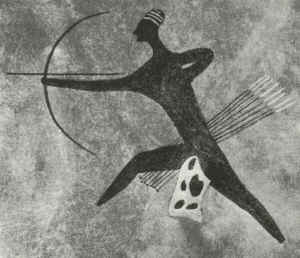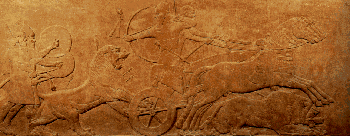HISTORY OF ARCHERY
Archery is one of the oldest arts still practised. This history will not only take you through a journey on the evolution of archery, but also through the history of mankind. Indeed, both are closely linked. Evidence of ancient archery has been found throughout the world, even in Australia where it had previously been thought that the bow had not been used.
Although archery probably dates to the Stone Age (around 20?000 BC), the earliest people known to have used the bow and arrow were the ancient Egyptians, who adopted it at least 5000 years ago for purposes of hunting and warfare.
In 1200 BC , the Hittites would use the bow from light, fast chariots that enabled them to become dreaded opponents in Middle Eastern battles. Their neighbours, the Assyrians used archery extensively. They built bows from several different types of material : tendon, horn and wood. They also gave the bow a new, recurved shape that was far more powerful and as it was shorter, it was more easily handled by an archer on horseback.
In China, archery dates back to the Shang dynasty (1766-1027 BC). A war chariot of that time carried a three-man team : driver, lancer and archer. During the ensuing Zhou (Chou) dynasty (1027-256 BC), nobles at court attended sport archery tournaments that were accompanied by music and interspersed with elegant salutations.
Chinese civil archery introduced to Japan from the 6th century had an overriding influence on later etiquette and techniques. One of Japan?s martial arts was originally known as kyujutsu (the art of the bow), now known as kyudo (way of the bow). Kyudo today continues to be taught in the traditionally prescribed manner. After certain ritual movements, the archer advances with deliberate steps to the shooting line and shoots at a target 36 cm in diameter set in a bank of sand that is roofed over, from a distance of 28 meters. The bow is 2.21 meter-long and made of laminated strips of bamboo and wood.
In the Greco-Roman period, the bow was more used for personal exploits or hunting, rather than warfare. Archers are frequently seen on pottery at that time. Both the Greeks and the Romans used Cretan as archers. The Romans are said to have been second-rate archers as until the fifth century their bows were shot by drawing the string to the chest, instead of the longer draw to the face which gives the arrow far more accuracy. Their opponents had often far better skills. The Parthians for instance were horsemen who developed the skill of swivelling around in the saddle and could shoot backwards at full gallop.
Middle Eastern superiority in archer equipment and technique continued for centuries. With bows like those of the Assyrians and Parthians, Attila the Hun and his Mongols conquered much of Europe and Asia, and Turkish archers threw back the Crusaders.
For Native Americans, the bow was both a means of subsistence and existence before and during the days of English and later American colonisation. This has been the case, and still is in some countries, on the African continent.
(A Brief History of Archery)
The discovery of the first stone arrowheads in Africa tends to indicate that the bow and arrow were invented there, maybe as early as 50,000 BC.
It was probably developed in conjunction with the invention of the spear thrower.
A short bow would be a better hunting weapon when used to stalk animals in wooded areas, rather than carry around long spears.
The shape of the earliest bows can only be guessed at, as broken or worn out bows would probably end up on the cooking fire, reshaped into different tools or just thrown away.
Fire hardened points used on the arrows. Flint arrowheads shaped to a point and inserted into a slot and tied with sinew to the front of the arrow. Feathers were glued and tied with sinew to the arrow shafts.
11,000 BC - In a burial tomb in San Teodoro Cave, Sicily, a skeleton was found with a fragment of a flint arrow head embedded in the pelvis.
Arrow shafts found in Germany are dated to approx. 9,000 BC
| Bows are found in Denmark that date from approx. 8,000 - 6,000 BC.
These bows are one piece made from yew or elm and are 'tillered'. (Even amount of bend on top and bottom limbs.)  | Tassili rock fresco depicting archer in Egypt from about 7,500 BC. | |
 | 5,000 BC - the Egyptians use the bow for hunting and in warfare against the Persians. |
3,300 BC - a 45 yr. old man dies on the Similaun Glacier in the Alps near the present day border between Italy and Austria. His preserved body is found on 11th. September, 1991.
After many years of research, "Oetzi" has revealed how he once lived and worked.
He was dressed in leather clothes with a grass waterproof cloak and shoes stuffed with grass as protection against the weather.
He also had a framed backpack, a utility belt containing tools, a quiver containing 14 arrows, a flint dagger and most amazing of all, a copper axe.
The reason why the discovery of the copper axe caused such interest is that it pre-dates the generally accepted development of copper smelting by almost 1,000 years.
(So now the history books have to be revised.)
After detailed analysis of body tissue and hair, it was discovered to contain high amounts of copper and arsenic, which can only come about from prolonged exposure to copper ore and the smelting process. This indicates that he mined the copper ore, probably from ancient mines found 120km. to the South in Italy and then melted the ore in a furnace to create the copper axe.
His quiver had a protective flap to keep the feathers dry on the arrows.
The wooden arrows were fitted with flint arrowheads. Some of his arrows were shorter than the others and seemed to have been made by a right-handed person indicated by the direction of the thread used to tie on the feathers. The other arrows were longer and made by a left-handed person. Why he had two different lengths of arrows remains unknown.
One possible scenario on how he lived his life is that during the winter he would travel to the copper mines. There he would mine the ore and make copper axes, possibly to trade for other items. During the summer, he would take flocks of sheep up the mountain passes to graze, maybe using his bow and arrow to protect the sheep from wolves and also for hunting. He may have traded some arrows for one of his copper axes during his travels.
cont on page 2
 Free Forum Hosting
Free Forum Hosting